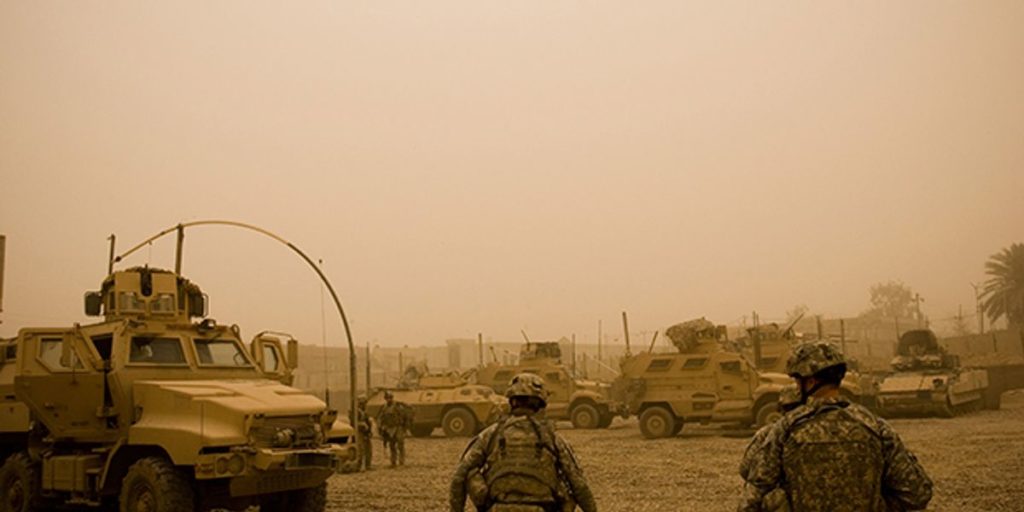Neutralizing an IED means either disabling it or destroying it. Both jobs are performed by military specialists trained in the rapidly expanding discipline known as explosive ordnance disposal, or EOD.
U.S. EOD teams travel in 26-ton technology-stuffed trucks called Joint EOD Rapid Response Vehicles (JERRVs) that cost more than $1.2 million fully equipped (the JERRV was also a JIEDDO project). The teams, usually made up of two or three people, strive to disable and recover unusual IEDs because of their intelligence value. Those recovered IEDs, as well as forensic evidence gathered at places where IEDs have detonated, are sent to a laboratory near Baghdad airport for analysis. IED specialists say that years of work at that lab have enabled them to know, in many cases, such details as exactly who built an IED and possibly where he built it.
If the IED isn’t unusual, or if disabling it doesn’t seem straightforward, the EOD technicians use special-purpose robots to place plastic explosives on it and blow it up. [In next month’s issue, IEEE Spectrum will publish a companion article to this one, on EOD in Iraq.]
There are other ways to neutralize an IED. A type of “predetonator” used in Iraq emits a strong electromagnetic pulse that wrecks the integrated circuits in the cellphone or other appliance that triggers an IED. The pulse comes from a very high voltage capacitor discharging very suddenly. When its ICs are zapped, the trigger might “fail open”—with no explosion—or it might “fail closed,” detonating the IED.
Inevitably, there has been a countermeasure, and a cheap one at that. “These are billion-dollar solutions with ten-cent countermeasures,” says Daniel B. Widdis, an instructor at the Naval Postgraduate School, in Monterey, Calif., who did a tour as an electronic countermeasures specialist in Iraq. [ Editor’s note: In response to JIEDDO’s request, IEEE Spectrum agreed not to disclose the countermeasure.]
More sophisticated predetonators are said to mimic the signals of the IEDs’ triggering devices in order to set them off. In the typical case the triggering devices, and therefore the specific codes that will trigger them, are not known. In an interview published in the 3 September 2007 issue of Aviation Week and Space Technology, James M. Smith, the CEO of EDO Corp., said that the predet systems transmit sequences of codes very rapidly. When the right code comes up, the IED detonates. The technique doesn’t work, however, if the code is long—say, 18 bits or more. There are simply too many possible combinations, Smith said.
In February, JIEDDO announced that it had canceled two big predetonator programs, code-named Alexis and Electra-C, on the grounds that the signals from those systems interfered with counter-IED jammers such as Duke. A third program, called Blow Torch, is ongoing.
An article in the 25 March edition of The Scotsman newspaper, which quoted only anonymous sources, said that U.S. forces in Iraq and Afghanistan were using specially equipped Vietnam-era EA-6B Prowler aircraft to clear roads for convoys by transmitting appropriate signals to predetonate IEDs. (The article said the sweeps are called courtesy burns.)
A former JIEDDO official points to a tempting but difficult challenge for future predetonators. “It would be a breakthrough if we could find a safe and effective way to predetonate blasting caps,” he says. “To underline the difficulty, remember that industrial and military caps are designed to not react to the static electricity that creates lightning.”
How do you mitigate an IED blast? Today, mostly with armor. Over the past year and a half, contractors and soldiers have gone from 3-ton SUVs to 7.8-ton Revas, and from 5-ton Humvees to 25-ton MRAPs and JERRVs.
Of course, there are disadvantages. Tons of armor make vehicles too sluggish to speed away from an ambush. And simple physics and economics confirm that in an escalating contest between bombs and armor, it’s much cheaper and easier to make bigger bombs than to try to shield against those bombs with more and more armor.
But armor isn’t the only factor in the life-death equation. MRAPs and JERRVs are much higher off the ground than Humvees, and parts of their undercarriages are V-shaped. The V shape deflects the force of a blast under the vehicle outward, away from the vehicle. The increased height not only puts more distance between the passenger compartment and a bomb buried in the road, it also makes it more difficult for insurgents to target the passenger compartment with an explosively formed penetrator.
The first MRAPs were delivered to Iraq in January 2007; there are now more than 3200 of them in combat roles. There have been more than 150 IED attacks on MRAPs, the U.S. Defense Department says, which resulted in a total of eight deaths. All the fatal attacks involved either an EFP or a deep-buried IED. The Defense Department plans to spend $5.4 billion to buy 4000 more MRAPs, making this acquisition program the Pentagon’s third largest (only missile defense and the Joint Strike Fighter are bigger).
Future combat trucks will mitigate blasts with more than simple armoring. Some of the competing designs for the Joint Light Tactical Vehicle, the MRAP’s proposed more agile but no-less-blast-resistant successor, take inventive approaches. For example, to reduce the organ- and spine-crushing shock from a blast that comes from below, some JLTV designs suspend their seats from the ceiling, rather than bolting them to the floor.
“If I can vastly mitigate the effects of an attack, I would argue that that is defeating the IED, too,” says the Lexington Institute’s Gouré.


